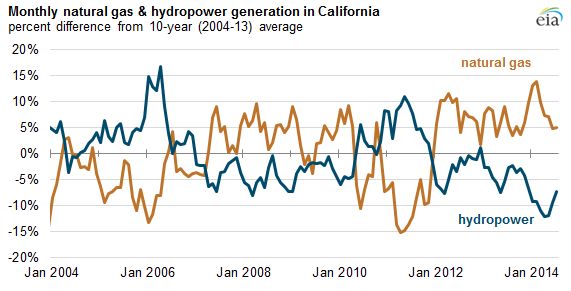California’s drought hasn’t just left its mark on dried-up fields and suburban lawns. It’s also sapped the state’s supply of hydropower, leaving natural-gas-fired generators -- and a growing share of solar and wind power -- to make up the difference.
During the first half of 2014, hydropower accounted for only 10 percent of California’s electricity generation, the U.S. Energy Information Administration reported Monday. That’s half the average 20 percent it provided during the first half of every year from 2004 to 2013, as the following chart shows.

California has been in a state of drought emergency since January, with more than half of the state in the most severe category on the charts. The state’s hydroelectric dams are primarily fed by Sierra Nevada snows, which have been at record lows. That’s left some reservoirs dry enough to expose Gold Rush-era buildings submerged decades ago.

Traditionally, natural-gas-fired power plants are California’s backup resource for hydropower, the EIA noted. Indeed, over the past decade, monthly hydropower and natural gas generation have tracked one another closely, with gas-fired power rising when hydro falls, and visa versa, as shown below.

This remains true today. The California Independent System Operator (CAISO), which runs the state’s transmission grid, has projected that this summer’s hydro shortfall will be adequately covered by the state’s natural-gas power plants. But it also noted that solar and wind power were for the first time playing a significant role in making up these shortfalls as well.
In the months of February and March, wind power generation surpassed hydroelectric power for the first time in California's history. And of the 3,243 megawatts of new generation that came on-line this summer, 61 percent was solar, nearly double natural gas’ 32 percent, according to CAISO’s 2014 Summer Loads and Resources Assessment (PDF).
California’s energy regulators and grid operators are adapting new rules for balancing this new mix of intermittent, distributed renewable energy with its traditional resources. While the state pursues its renewable energy and greenhouse gas reduction goals, it’s important to remember that water is as critical a resource as energy -- and that the two can’t really be separated from one another. Indeed, much of Southern California’s grid challenges are linked to the shutdown of once-through cooling gas-fired power plants in the region under state water regulations.
Meanwhile, the loss of the San Onofre Nuclear Generation Station (SONGS) has cut the state’s baseload nuclear power resources in half, putting pressure on Southern California Edison and San Diego Gas & Electric to incorporate distributed resources like rooftop PV, energy storage, energy efficiency and demand response into their plans for making up for the loss.
Hydropower is the cheapest form of green energy around, as well as the cheapest form of energy storage in the form of pumped hydro. Still, it's another baseload resource that's proving less than reliable amidst the disruptions linked to climate change. The EIA reports that solar, wind, geothermal and biomass energy surpassed hydropower for the first time across the country this year. There simply aren't that many untapped dam sites left -- but there's still plenty of room for wind and solar to grow.



